SUPPORTING ENVIRONMENTS FOR SOCIAL DYSTOPIA:
▪ page 1: Metropolis (1927) ▪ Metropolis (2001)
page 2:
Blade Runner ▪ Akira
“Above all, Metropolis is a film of powerfully expressive architectural metaphors, a gallery of contemporary visions, and an important turning point in the development of film architecture.”
– author Dietrich Neumann, 1999, p. 94
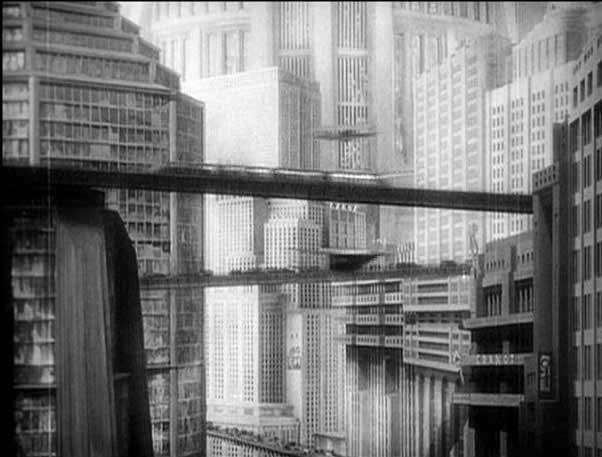 Like Brazil, Metropolis (Lang 1927) is not meant to portray any existing location but to exploit the unsettling possibility of being anywhere. Like Alphaville, it is designed as a believable vision of a future city. The styles used are mostly modernist and art deco, but the sets are ahead of their time – none are real, and scale models are used extensively. The urban scale of Metropolis exceeded anything existing at the time, although director Fritz Lang attributed the design to his experience of the Manhattan skyline (Sutcliffe 1984). Metropolis (1927) is set in a city with culture and history, where archetypal monuments have been selectively preserved amidst towering skyscrapers: the gothic cathedral, the inventor’s rustic house, and the ancient catacombs. All of these architectural exceptions are places of significant action in the film, where the routines of Metropolis are broken.
Like Brazil, Metropolis (Lang 1927) is not meant to portray any existing location but to exploit the unsettling possibility of being anywhere. Like Alphaville, it is designed as a believable vision of a future city. The styles used are mostly modernist and art deco, but the sets are ahead of their time – none are real, and scale models are used extensively. The urban scale of Metropolis exceeded anything existing at the time, although director Fritz Lang attributed the design to his experience of the Manhattan skyline (Sutcliffe 1984). Metropolis (1927) is set in a city with culture and history, where archetypal monuments have been selectively preserved amidst towering skyscrapers: the gothic cathedral, the inventor’s rustic house, and the ancient catacombs. All of these architectural exceptions are places of significant action in the film, where the routines of Metropolis are broken.
 Deliberately crafting the city of the film in relation to contemporary cities, the urban environment creates a tangible connection between the world of the audience and the world of the film. This is in opposition to the aims of Caligari’s set designs, because Metropolis (1927) does not need to operate in a different world: indeed, the political and social messages of the film are most poignant when the city presents the film as a real possible future.
Deliberately crafting the city of the film in relation to contemporary cities, the urban environment creates a tangible connection between the world of the audience and the world of the film. This is in opposition to the aims of Caligari’s set designs, because Metropolis (1927) does not need to operate in a different world: indeed, the political and social messages of the film are most poignant when the city presents the film as a real possible future.
“The experience of the city itself in Metropolis is one of fear, danger, and oppression, of loneliness and unsuccessful struggle.”
- author Dietrich Neumann, 1999, p. 36
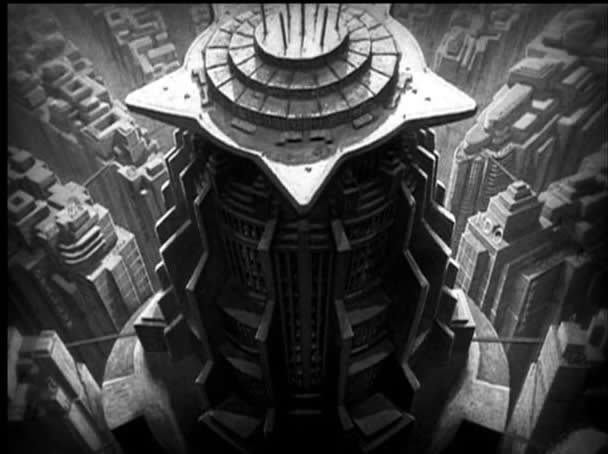 Metropolis (1927) presents two distinct urban environments, each a symbolic model of the lifestyle that exists there. In the City of Designers, polished modern towers glitter between smoothly-flowing transit routes. The buildings are gracefully tall, with diverse forms, and suggest a richness of detail and materials. Social hierarchy is represented throughout the urban environment: the taller and more decorative the building, the more power and money expressed. Thus Joh Fredersen’s office, the proverbially-named Tower of Babel, is the city’s tallest building with the most iconic form.
Metropolis (1927) presents two distinct urban environments, each a symbolic model of the lifestyle that exists there. In the City of Designers, polished modern towers glitter between smoothly-flowing transit routes. The buildings are gracefully tall, with diverse forms, and suggest a richness of detail and materials. Social hierarchy is represented throughout the urban environment: the taller and more decorative the building, the more power and money expressed. Thus Joh Fredersen’s office, the proverbially-named Tower of Babel, is the city’s tallest building with the most iconic form.
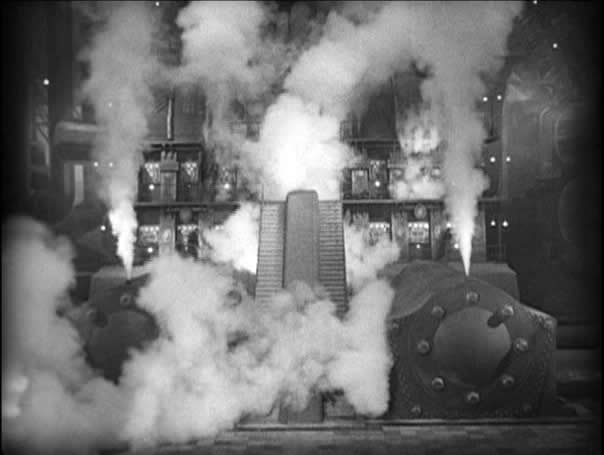 This city above ground stands in marked contrast to the workers’ city underground, a physical indication of the social stratification essential to the plot. Based on medieval cosmology – sacred above and profane below - this hierarchy is a common technique used to construct social dystopias, which is carried through many films. In the City of Workers all the graceless buildings look alike – as the uniformed workers themselves do - lined up under fluorescent lights, smaller and shorter than the towers above. The brutalist buildings here seem to have no detail at all, no decoration, built of pure necessity: as in Alphaville, the monotony adds to the eerie feeling that this environment is less than human. The mechanic way of life of the working class is illustrated in physical form by the hard banality of their urban environment, just as the affluence and comforts of the upper classes are clearly represented in the gracious urban spaces above.
This city above ground stands in marked contrast to the workers’ city underground, a physical indication of the social stratification essential to the plot. Based on medieval cosmology – sacred above and profane below - this hierarchy is a common technique used to construct social dystopias, which is carried through many films. In the City of Workers all the graceless buildings look alike – as the uniformed workers themselves do - lined up under fluorescent lights, smaller and shorter than the towers above. The brutalist buildings here seem to have no detail at all, no decoration, built of pure necessity: as in Alphaville, the monotony adds to the eerie feeling that this environment is less than human. The mechanic way of life of the working class is illustrated in physical form by the hard banality of their urban environment, just as the affluence and comforts of the upper classes are clearly represented in the gracious urban spaces above.
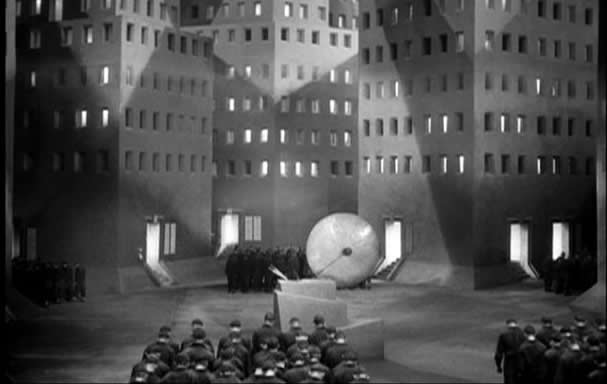 “Set in the year 2000 or thereabouts, [Metropolis] was an extrapolation of existing tendencies in technology and class conflict … The ‘city’ of jostling skyscrapers with underground factories and workers’ homes was merely a convenient expression of these political forces …”
“Set in the year 2000 or thereabouts, [Metropolis] was an extrapolation of existing tendencies in technology and class conflict … The ‘city’ of jostling skyscrapers with underground factories and workers’ homes was merely a convenient expression of these political forces …”
-
Anthony Sutcliffe 1984, p. 168
Thus in Metropolis (1927) two very different types of urban environment are presented to typify the characters within it, defining which class they belong to – the architecture is an aid to character development. Dystopia is created by the socio-political structure of the film, explained and supported by the opposing urban environments which underline the differences between social castes, from which tension the plot unfurls. The sets communicate the state of the future city, projecting social ills and working-class issues of the present into the future as an extreme scenario, which the action of the film proceeds to resolve. This is the same approach used in Metropolis (2001), Blade Runner and Akira, discussed below.
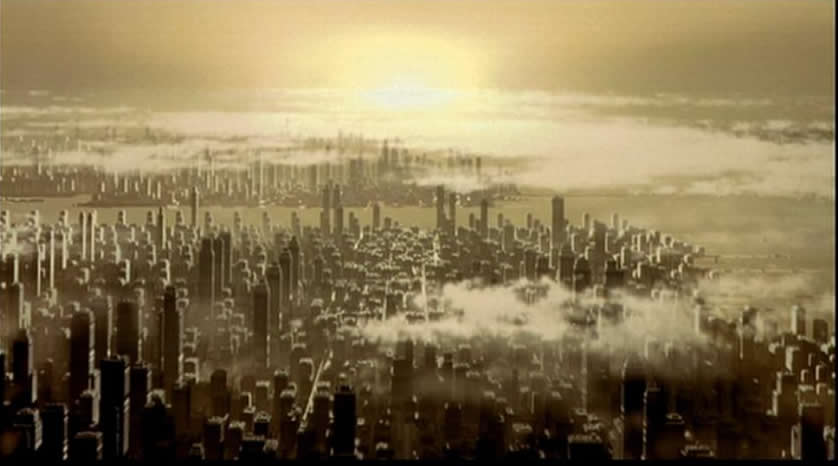 Metropolis (Tezuka 2001) parallels the 1927 film in name as well as in plot, and likewise uses the urban environment as a parody of social dystopia. Although Tezuka denied having seen Metropolis (1927) before creating this anime film, he attributed the look of the city to photos of New York’s skyscrapers – which was also Lang’s inspiration (Martin 2001).
Metropolis (Tezuka 2001) parallels the 1927 film in name as well as in plot, and likewise uses the urban environment as a parody of social dystopia. Although Tezuka denied having seen Metropolis (1927) before creating this anime film, he attributed the look of the city to photos of New York’s skyscrapers – which was also Lang’s inspiration (Martin 2001).
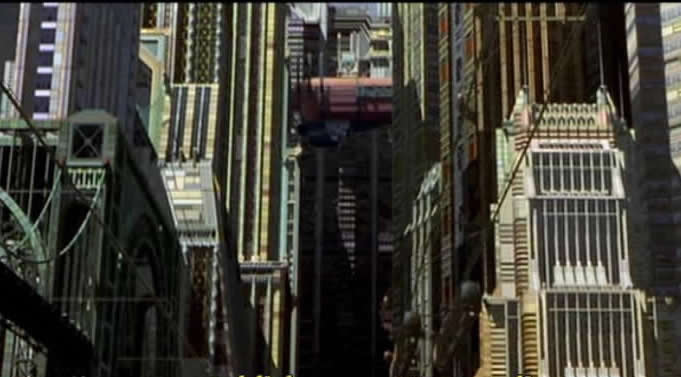 The city on the surface is a hyper-modern utopia, with multiple zones beneath: a physical hierarchy correspondent to the oppressive social echelon. Conceived at an expansive scale with miles of beautiful modernist and art deco towers, this urban environment is elegant and architecturally diverse, elaborately detailed with refined colour and with rich materials.
The city on the surface is a hyper-modern utopia, with multiple zones beneath: a physical hierarchy correspondent to the oppressive social echelon. Conceived at an expansive scale with miles of beautiful modernist and art deco towers, this urban environment is elegant and architecturally diverse, elaborately detailed with refined colour and with rich materials.
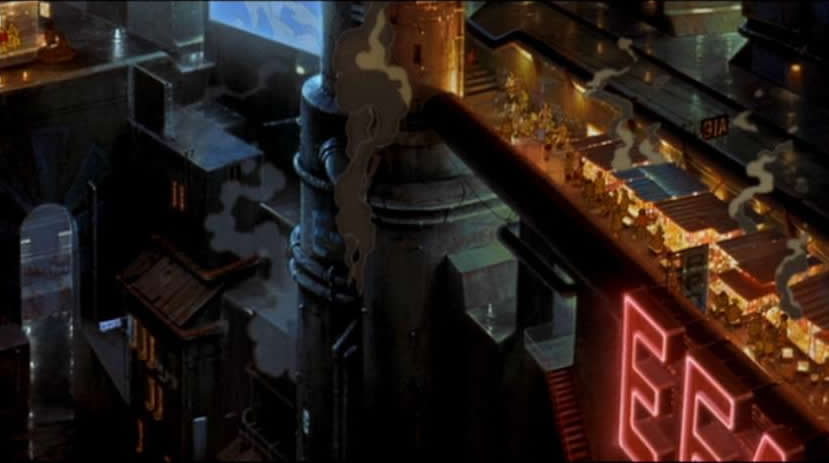 Zone 1 below the city is for outcasts and the robots essential to the economy, who – like the workers in Metropolis (1927) – are not permitted to enter the city above. Below this second city are the industrial areas: Zone 2 is the power plant which supports the city, and Zone 3 is a giant garbage and sewer disposal.
Zone 1 below the city is for outcasts and the robots essential to the economy, who – like the workers in Metropolis (1927) – are not permitted to enter the city above. Below this second city are the industrial areas: Zone 2 is the power plant which supports the city, and Zone 3 is a giant garbage and sewer disposal.
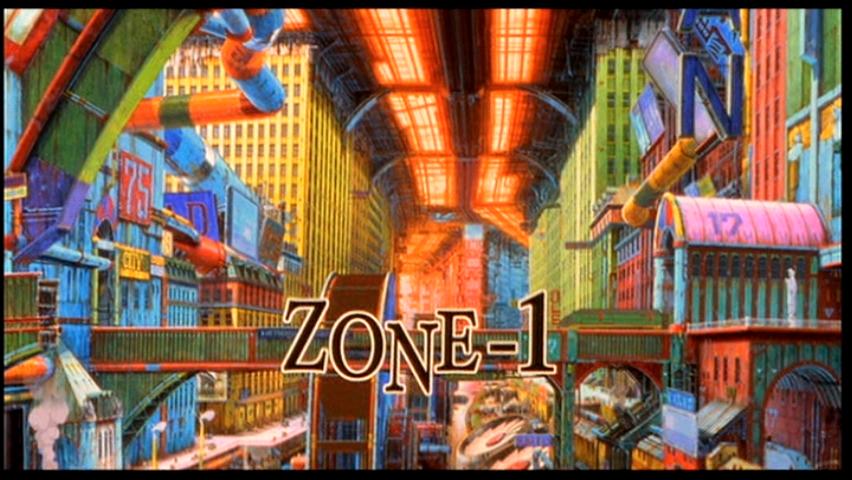 Unlike Lang's Metropolis, the world beneath the city is anything but monotonous: each Zone has a distinct look and different colour scheme, as the lighting changes between levels. Zone 1, the underground city, looks like a carnival: garish colours, harsh artificial lights against the darkness, a cacophony of neon signs, deep shadows, and eerie green and blue alleyways. The underground world feels disorienting and dangerous, a slum city of decrepit buildings abandoned to decay along with their inhabitants.
Unlike Lang's Metropolis, the world beneath the city is anything but monotonous: each Zone has a distinct look and different colour scheme, as the lighting changes between levels. Zone 1, the underground city, looks like a carnival: garish colours, harsh artificial lights against the darkness, a cacophony of neon signs, deep shadows, and eerie green and blue alleyways. The underground world feels disorienting and dangerous, a slum city of decrepit buildings abandoned to decay along with their inhabitants.
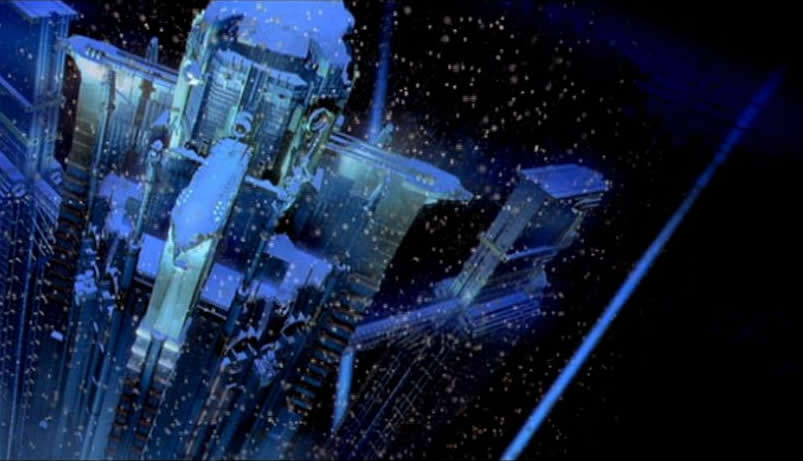 The city above is futuristic and fantastic, while the sordid city below resembles a festering ghetto that could be found in the world today – but both are as deliberately ‘cast’ and suggestively designed as the characters in the animated film. Thus each urban space used, as in Metropolis (1927), acts as a caricature of the society which inhabits it and the differences between them, which drive the tension of the plot. Blade Runner also addresses social hierarchy and issues of technology versus morality, using very similar techniques.
The city above is futuristic and fantastic, while the sordid city below resembles a festering ghetto that could be found in the world today – but both are as deliberately ‘cast’ and suggestively designed as the characters in the animated film. Thus each urban space used, as in Metropolis (1927), acts as a caricature of the society which inhabits it and the differences between them, which drive the tension of the plot. Blade Runner also addresses social hierarchy and issues of technology versus morality, using very similar techniques.














